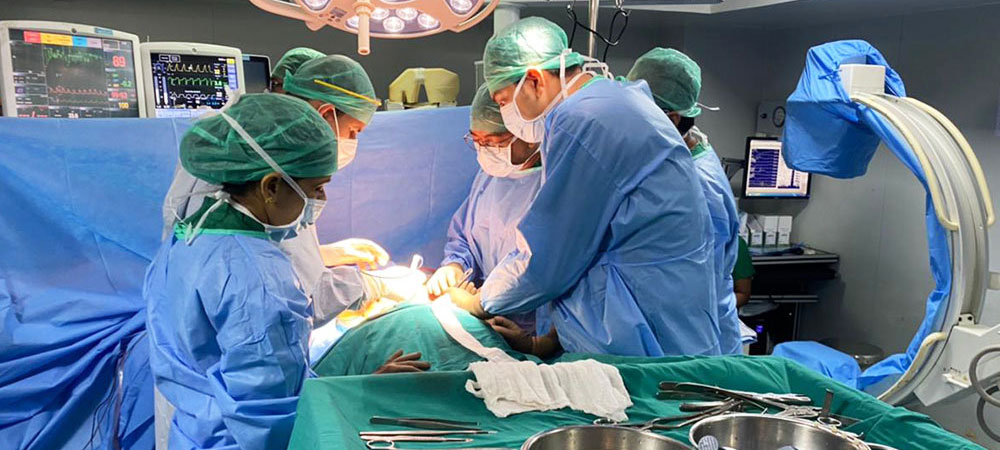Cervical Myelopathy is a progressive spinal disorder that typically develops with age-related changes in the body. The spinal cord gets squeezed in the neck (cervical) region in this condition, which further escalates the symptoms of a neurological nature. It commonly results from degenerative changes like cervical spondylosis, disc herniation, or spinal stenosis. If untreated, it can lead to loss of coordination, balance issues, hand clumsiness, and even paralysis.
At his clinic, Dr. Mayukh Guha provides advanced and compassionate cervical myelopathy treatment in Siliguri. Using cutting-edge diagnostic techniques and individualized care protocols, he helps patients regain mobility, reduce pain, and prevent long-term neurological damage.
2000+
Successful Spine Surgeries
95%
Patient Satisfaction Rate Meet Our Cervical Myelopathy Specialist in Siliguri
With over 8 years of experience in neuro and spine surgery, Dr. Mayukh Guha is one of the most trusted specialists for treating cervical myelopathy in Siliguri. He blends surgical precision with patient-first care, ensuring holistic recovery from spinal cord compression.
Dr. Mayukh Guha
MBBS, MS Orthopaedics (GOLD MEDALIST), FNB Spine Surgery (ISIC, New Delhi), FMISS, DNB (Orthopaedics), MRCS, MNAMS
Consultant Spine Surgeon in Siliguri, North Bengal Early Signs of Cervical Myelopathy You Shouldn't Ignore
Cervical myelopathy develops gradually, and its early symptoms are often mistaken for routine neck issues. Identifying these warning signs early on can play a crucial role in preventing lasting spinal cord damage.

Neck pain and stiffness
Discomfort in the neck, especially during movement, which may spread to the shoulders or upper arms.

Numbness in the arms or hands
A frequent sign of spinal cord compression, often described as “pins and needles” or decreased sensation.

Poor hand coordination
Tasks requiring fine motor skills—like writing, buttoning, or using utensils—may become difficult.

Balance issues or frequent falls
As compression worsens, walking may become unstable, increasing fall risk.

Weakness in arms or legs
Gradual loss of strength in the limbs may affect grip, lifting, or walking ability.
Personalized Cervical Myelopathy Diagnosis & Treatment in Siliguri
Dr. Mayukh Guha takes good care of his patients by providing proper treatment procedures for cervical myelopathy treatment in Siliguri, beginning with the diagnosis of cervical myelopathy, followed by a thorough assessment, and then moving along to tailored plans for your specific needs. The design of the plan is made to remove any compression of the spine, assisting with speedy recovery, and enhancing the overall quality of your life.
Read about Endoscopic Spine Surgery
here.How Cervical Myelopathy Is Diagnosed
Accurate diagnosis is crucial to avoid permanent nerve damage. Dr. Guha uses a thorough, step-by-step evaluation process:
Medical History & Physical Examination:
Evaluating symptoms such as neck discomfort, numbness, coordination difficulties, balance problems, or hand clumsiness, along with assessing reflexes and motor function.
MRI & Imaging Tests:
MRI scans are the gold standard for locating spinal cord compression and evaluating its severity. CT scans or X-rays may also be used.
Neurological Tests:
In selected cases, nerve conduction studies or EMG help assess nerve and muscle function in the limbs.
Tailored Treatment Options
Depending on some conditions, the treatment plan is designed, such as the overall age of the patient, the seriousness of the illness, and the level of the disorder.
Medication & Pain Relief
For mild or early-stage cases, anti-inflammatory drugs, neuropathic pain medications, and muscle relaxants may offer symptom relief.
Conservative Care
Physical therapy, posture correction, and cervical collars (used short-term) may help alleviate pressure and improve neck mobility.
Surgical Intervention (If Required)
If spinal cord compression is severe or symptoms worsen, surgery may be necessary to prevent further nerve damage. Common procedures include Anterior Cervical Discectomy and Fusion (ACDF), Laminectomy or Laminoplasty, and Posterior Cervical Fusion. Whenever possible, Dr. Guha uses minimally invasive techniques to ensure quicker recovery and reduced risk.
Post-Surgical Rehabilitation
After surgery, patients receive a tailored physiotherapy plan focusing on restoring balance, hand coordination, and neck flexibility.

Patient Testimonials
After a major accident, I feared I’d never walk properly again. Dr. Guha’s expertise in spinal trauma care gave me a second chance at life!

Arjun Das
India I suffered from unbearable sciatic pain for years. Thanks to Dr. Guha’s treatment, I finally found relief and can move freely again!

Priya Verma
India Dr. Guha’s treatment for my spinal deformity was life-changing. My mobility has improved significantly, and I can now enjoy daily activities without discomfort.

Vikash Agarwal
India Living with scoliosis was challenging, but Dr. Guha’s surgery transformed my posture and confidence. My recovery was quicker than I ever imagined!

Sneha Roy
India I was struggling with severe spinal issues, and surgery was my last hope. Dr. Guha performed the procedure with precision, and now I’m pain-free and active again!

Ravi Menon
India Dr. Mayukh Guha’s expertise in minimally invasive spine surgery made my recovery smooth and pain-free. I was back on my feet much sooner than expected!

Amit Khanna
India Why Choose Dr. Guha for Cervical Myelopathy Treatment in Siliguri?
- Neuro-Spine Expertise
Years of hands-on experience in treating cervical spine disorders and complex nerve compressions. - Patient-Focused Approach
Every treatment plan is uniquely tailored to the patient's symptoms, diagnosis, and long-term goals. - Continuous Monitoring & Recovery Support
With regular check-ins and rehabilitation guidance, Dr. Guha ensures patients heal safely and steadily.

Frequently Asked Questions
Answer : Cervical myelopathy refers to spinal cord compression in the neck region, commonly resulting from cervical spondylosis—a condition marked by the degeneration of the cervical discs. While spondylosis affects the discs and vertebrae, myelopathy impacts the spinal cord itself, potentially causing neurological impairments.
Answer : Surgery is needed when conservative treatments fail or if there’s significant spinal cord compression causing neurological deficits.
Answer : Surgical intervention for cervical myelopathy is highly effective, with success rates typically between 80% to 90%. The overall result is primarily influenced by the severity of the condition and how promptly the surgery is performed. Many patients report notable improvements in pain relief, mobility, and overall neurological function post-surgery.
Answer : Diagnosis of cervical myelopathy treatment in Siliguri typically includes neurological assessments and imaging techniques such as MRI to visualize spinal cord compression.
Answer : Non-surgical treatments include medications, physical therapy, posture correction, and lifestyle modifications to manage symptoms and prevent progression.
Answer : Recovery time varies, but most patients begin physiotherapy within days and show significant improvement in 4–6 weeks, with full recovery taking a few months.
Answer : In the early stages, you may still walk, but as the condition progresses, it can lead to balance issues, difficulty walking, or even paralysis. Surgery can help improve mobility and prevent further loss of function.





